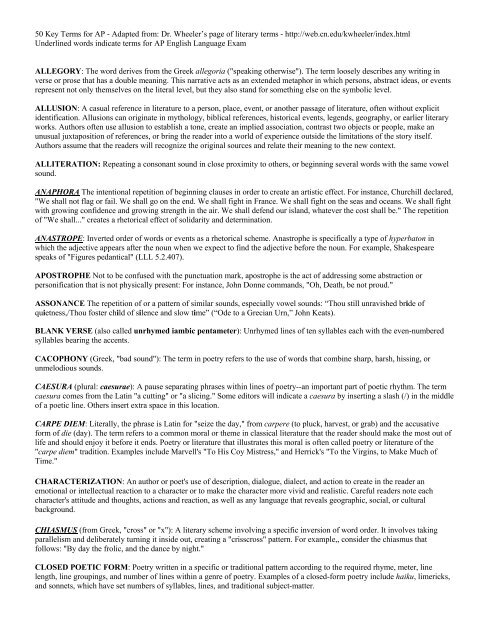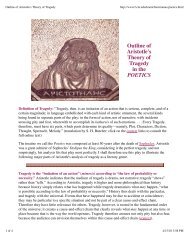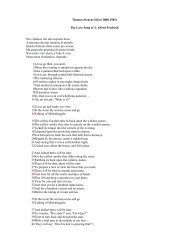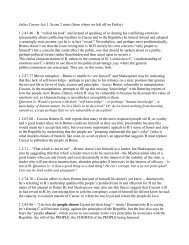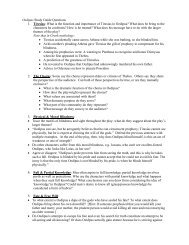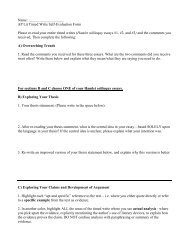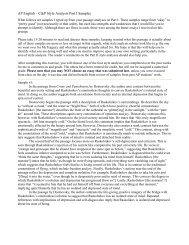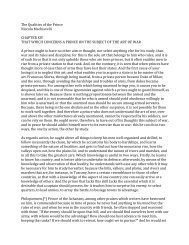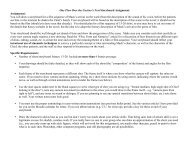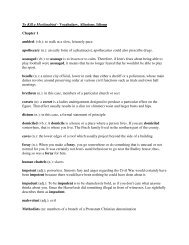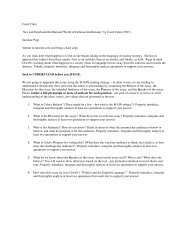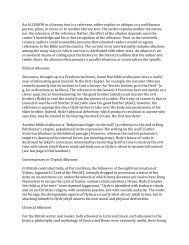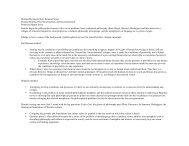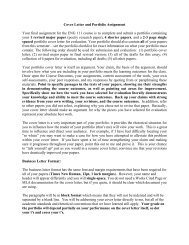50 Key Terms for AP - Adapted from: Dr. Wheeler's page of literary ...
50 Key Terms for AP - Adapted from: Dr. Wheeler's page of literary ...
50 Key Terms for AP - Adapted from: Dr. Wheeler's page of literary ...
You also want an ePaper? Increase the reach of your titles
YUMPU automatically turns print PDFs into web optimized ePapers that Google loves.
<strong>50</strong> <strong>Key</strong> <strong>Terms</strong> <strong>for</strong> <strong>AP</strong> - <strong>Adapted</strong> <strong>from</strong>: <strong>Dr</strong>. Wheeler’s <strong>page</strong> <strong>of</strong> <strong>literary</strong> terms - http://web.cn.edu/kwheeler/index.html<br />
Underlined words indicate terms <strong>for</strong> <strong>AP</strong> English Language Exam<br />
ALLEGORY: The word derives <strong>from</strong> the Greek allegoria ("speaking otherwise"). The term loosely describes any writing in<br />
verse or prose that has a double meaning. This narrative acts as an extended metaphor in which persons, abstract ideas, or events<br />
represent not only themselves on the literal level, but they also stand <strong>for</strong> something else on the symbolic level.<br />
ALLUSION: A casual reference in literature to a person, place, event, or another passage <strong>of</strong> literature, <strong>of</strong>ten without explicit<br />
identification. Allusions can originate in mythology, biblical references, historical events, legends, geography, or earlier <strong>literary</strong><br />
works. Authors <strong>of</strong>ten use allusion to establish a tone, create an implied association, contrast two objects or people, make an<br />
unusual juxtaposition <strong>of</strong> references, or bring the reader into a world <strong>of</strong> experience outside the limitations <strong>of</strong> the story itself.<br />
Authors assume that the readers will recognize the original sources and relate their meaning to the new context.<br />
ALLITERATION: Repeating a consonant sound in close proximity to others, or beginning several words with the same vowel<br />
sound.<br />
AN<strong>AP</strong>HORA The intentional repetition <strong>of</strong> beginning clauses in order to create an artistic effect. For instance, Churchill declared,<br />
"We shall not flag or fail. We shall go on the end. We shall fight in France. We shall fight on the seas and oceans. We shall fight<br />
with growing confidence and growing strength in the air. We shall defend our island, whatever the cost shall be." The repetition<br />
<strong>of</strong> "We shall..." creates a rhetorical effect <strong>of</strong> solidarity and determination.<br />
ANASTROPE: Inverted order <strong>of</strong> words or events as a rhetorical scheme. Anastrophe is specifically a type <strong>of</strong> hyperbaton in<br />
which the adjective appears after the noun when we expect to find the adjective be<strong>for</strong>e the noun. For example, Shakespeare<br />
speaks <strong>of</strong> "Figures pedantical" (LLL 5.2.407).<br />
<strong>AP</strong>OSTROPHE Not to be confused with the punctuation mark, apostrophe is the act <strong>of</strong> addressing some abstraction or<br />
personification that is not physically present: For instance, John Donne commands, "Oh, Death, be not proud."<br />
ASSONANCE The repetition <strong>of</strong> or a pattern <strong>of</strong> similar sounds, especially vowel sounds: “Thou still unravished bride <strong>of</strong><br />
quietness,/Thou foster child <strong>of</strong> silence and slow time” (“Ode to a Grecian Urn,” John Keats).<br />
BLANK VERSE (also called unrhymed iambic pentameter): Unrhymed lines <strong>of</strong> ten syllables each with the even-numbered<br />
syllables bearing the accents.<br />
CACOPHONY (Greek, "bad sound"): The term in poetry refers to the use <strong>of</strong> words that combine sharp, harsh, hissing, or<br />
unmelodious sounds.<br />
CAESURA (plural: caesurae): A pause separating phrases within lines <strong>of</strong> poetry--an important part <strong>of</strong> poetic rhythm. The term<br />
caesura comes <strong>from</strong> the Latin "a cutting" or "a slicing." Some editors will indicate a caesura by inserting a slash (/) in the middle<br />
<strong>of</strong> a poetic line. Others insert extra space in this location.<br />
CARPE DIEM: Literally, the phrase is Latin <strong>for</strong> "seize the day," <strong>from</strong> carpere (to pluck, harvest, or grab) and the accusative<br />
<strong>for</strong>m <strong>of</strong> die (day). The term refers to a common moral or theme in classical literature that the reader should make the most out <strong>of</strong><br />
life and should enjoy it be<strong>for</strong>e it ends. Poetry or literature that illustrates this moral is <strong>of</strong>ten called poetry or literature <strong>of</strong> the<br />
"carpe diem" tradition. Examples include Marvell's "To His Coy Mistress," and Herrick's "To the Virgins, to Make Much <strong>of</strong><br />
Time."<br />
CHARACTERIZATION: An author or poet's use <strong>of</strong> description, dialogue, dialect, and action to create in the reader an<br />
emotional or intellectual reaction to a character or to make the character more vivid and realistic. Careful readers note each<br />
character's attitude and thoughts, actions and reaction, as well as any language that reveals geographic, social, or cultural<br />
background.<br />
CHIASMUS (<strong>from</strong> Greek, "cross" or "x"): A <strong>literary</strong> scheme involving a specific inversion <strong>of</strong> word order. It involves taking<br />
parallelism and deliberately turning it inside out, creating a "crisscross" pattern. For example,, consider the chiasmus that<br />
follows: "By day the frolic, and the dance by night."<br />
CLOSED POETIC FORM: Poetry written in a specific or traditional pattern according to the required rhyme, meter, line<br />
length, line groupings, and number <strong>of</strong> lines within a genre <strong>of</strong> poetry. Examples <strong>of</strong> a closed-<strong>for</strong>m poetry include haiku, limericks,<br />
and sonnets, which have set numbers <strong>of</strong> syllables, lines, and traditional subject-matter.
<strong>50</strong> <strong>Key</strong> <strong>Terms</strong> <strong>for</strong> <strong>AP</strong> - <strong>Adapted</strong> <strong>from</strong>: <strong>Dr</strong>. Wheeler’s <strong>page</strong> <strong>of</strong> <strong>literary</strong> terms - http://web.cn.edu/kwheeler/index.html<br />
Underlined words indicate terms <strong>for</strong> <strong>AP</strong> English Language Exam<br />
CONCEIT (also called a metaphysical conceit): An elaborate or unusual comparison--especially one using unlikely metaphors,<br />
simile, hyperbole, and contradiction. Be<strong>for</strong>e the beginning <strong>of</strong> the seventeenth century, the term conceit was a synonym <strong>for</strong><br />
"thought" and roughly equivalent to "idea" or "concept." It gradually came to denote a fanciful idea or a particularly clever<br />
remark. In <strong>literary</strong> terms, the word denotes a fairly elaborate figure <strong>of</strong> speech, especially an extended comparison involving<br />
unlikely metaphors, similes, imagery, hyperbole, and oxymora.<br />
CONNOTATION: The extra tinge or taint <strong>of</strong> meaning each word carries beyond the minimal, strict definition found in a<br />
dictionary.<br />
CONSONANCE: A special type <strong>of</strong> alliteration in which the repeated pattern <strong>of</strong> consonants is marked by changes in the<br />
intervening vowels. As M. H. Abrams illustrates in The Norton Anthology <strong>of</strong> English Literature, examples include linger, longer,<br />
and languor or rider, reader, raider, and ruder.<br />
COUPLET: Two lines--the second line immediately following the first--<strong>of</strong> the same metrical length that end in a rhyme to <strong>for</strong>m<br />
a complete unit.<br />
DENOTATION: The minimal, strict definition <strong>of</strong> a word as found in a dictionary, disregarding any historical or emotional<br />
connotation.<br />
DICTION: The choice <strong>of</strong> a particular word as opposed to others. A writer could call a rock <strong>for</strong>mation by many words--a stone, a<br />
boulder, an outcropping, a pile <strong>of</strong> rocks, a cairn, a mound, or even an "anomalous geological feature."<br />
ELEGY: In classical Greco-Roman literature, "elegy" refers to any poem written in elegiac meter (alternating hexameter and<br />
pentameter lines). More broadly, elegy came to mean any poem dealing with the subject-matter common to the early Greco-<br />
Roman elegies--complaints about love, sustained <strong>for</strong>mal lamentation, or somber meditations. Closely related to the pastoral<br />
elegy, the dirge or threnody is shorter than the elegy and <strong>of</strong>ten represented as a text meant to be sung aloud.<br />
ELLIPSIS (plural, ellipses): (1) In its oldest sense as a rhetorical device, ellipsis refers to the artful omission <strong>of</strong> a word implied<br />
by a previous clause. For instance, an author might write, "The American soldiers killed eight civilians, and the French eight."<br />
The writer <strong>of</strong> the sentence has left out the word soldiers after French, and the word civilians after eight. However, both words are<br />
implied by the previous clause, so a reader has no trouble following the author's thought. (2) In its more modern sense, ellipsis<br />
refers to a punctuation mark indicated by three periods to indicate material missing <strong>from</strong> a quotation . . . like so. This mark is<br />
common in MLA <strong>for</strong>mat <strong>for</strong> indicating partial quotations.<br />
END RHYME: Rhyme in which the last word at the end <strong>of</strong> each verse is the word that rhymes.<br />
ENJAMBEMENT (French, "straddling," in English also called "run-on line"): A line having no pause or end punctuation but<br />
having uninterrupted grammatical meaning continuing into the next line.<br />
EUPHONY (<strong>from</strong> Greek "good sound"): Attempting to group words together harmoniously, so that the consonants permit an<br />
easy and pleasing flow <strong>of</strong> sound when spoken,<br />
EXACT RHYME: Exact rhyme or perfect rhyme is rhyming two words in which both the consonant sounds and vowel sounds<br />
match to create a rhyme. The term "exact" is sometimes used more specifically to refer to two homophones that are spelled<br />
dissimilarly but pronounced identically at the end <strong>of</strong> lines. Since poetry is traditionally spoken aloud, the effect <strong>of</strong> rhyme<br />
depends upon sound rather than spelling, even words that are spelled dissimilarly can rhyme.<br />
FOIL: A character that serves by contrast to highlight or emphasize opposing traits in another character. For instance, in the film<br />
Chasing Amy, the character Silent Bob is a foil <strong>for</strong> his partner, Jake, who is loquacious and foul-mouthed. In Shakespeare's<br />
Hamlet, Laertes the unthinking man <strong>of</strong> action is a foil to the intelligent but reluctant Hamlet.<br />
FRAME NARRATIVE: The result <strong>of</strong> inserting one or more small stories within the body <strong>of</strong> a larger story that encompasses the<br />
smaller ones. Often this term is used interchangeably with both the <strong>literary</strong> technique and the larger story itself that contains the<br />
smaller ones, which are called "framed narratives" or "embedded narratives."<br />
HYPERBOLE: the trope <strong>of</strong> exaggeration or overstatement.
<strong>50</strong> <strong>Key</strong> <strong>Terms</strong> <strong>for</strong> <strong>AP</strong> - <strong>Adapted</strong> <strong>from</strong>: <strong>Dr</strong>. Wheeler’s <strong>page</strong> <strong>of</strong> <strong>literary</strong> terms - http://web.cn.edu/kwheeler/index.html<br />
Underlined words indicate terms <strong>for</strong> <strong>AP</strong> English Language Exam<br />
IMAGERY: A common term <strong>of</strong> variable meaning, imagery includes the "mental pictures" that readers experience with a<br />
passage <strong>of</strong> literature. It signifies all the sensory perceptions referred to in a poem, whether by literal description, allusion, simile,<br />
or metaphor. Imagery is not limited to visual imagery; it also includes auditory (sound), tactile (touch), thermal (heat and cold),<br />
olfactory (smell), gustatory (taste), and kinesthetic sensation (movement).<br />
INEXACT RHYME: Rhymes created out <strong>of</strong> words with similar but not identical sounds. In most <strong>of</strong> these instances, either the<br />
vowel segments are different while the consonants are identical, or vice versa. This type <strong>of</strong> rhyme is also called approximate<br />
rhyme, slant rhyme, near rhyme, half rhyme, <strong>of</strong>f rhyme, analyzed rhyme, or suspended rhyme.<br />
INTERNAL RHYME: A poetic device in which a word in the middle <strong>of</strong> a line rhymes with a word at the end <strong>of</strong> the same<br />
metrical line.<br />
IRONY: Cicero referred to irony as "saying one thing and meaning another." Irony comes in many <strong>for</strong>ms. Verbal irony (also<br />
called sarcasm) is a trope in which a speaker makes a statement in which its actual meaning differs sharply <strong>from</strong> the meaning<br />
that the words ostensibly express. Often this sort <strong>of</strong> irony is plainly sarcastic in the eyes <strong>of</strong> the reader, but the characters listening<br />
in the story may not realize the speaker's sarcasm as quickly as the readers do. <strong>Dr</strong>amatic irony (the most important type <strong>for</strong><br />
literature) involves a situation in a narrative in which the reader knows something about present or future circumstances that the<br />
character does not know. In that situation, the character acts in a way we recognize to be grossly inappropriate to the actual<br />
circumstances, or the character expects the opposite <strong>of</strong> what the reader knows that fate holds in store, or the character anticipates<br />
a particular outcome that unfolds itself in an unintentional way. Probably the most famous example <strong>of</strong> dramatic irony is the<br />
situation facing Oedipus in the play Oedipus Rex. Situational irony (also called cosmic irony) is a trope in which accidental<br />
events occur that seem oddly appropriate, such as the poetic justice <strong>of</strong> a pickpocket getting his own pocket picked. However,<br />
both the victim and the audience are simultaneously aware <strong>of</strong> the situation in situational irony.<br />
JUXT<strong>AP</strong>OSITION: The arrangement <strong>of</strong> two or more ideas, characters, actions, settings, phrases, or words side-by-side or in<br />
similar narrative moments <strong>for</strong> the purpose <strong>of</strong> comparison, contrast, rhetorical effect, suspense, or character development.<br />
MET<strong>AP</strong>HOR: A comparison or analogy stated in such a way as to imply that one object is another one, figuratively speaking.<br />
METER: A recognizable though varying pattern <strong>of</strong> stressed syllables alternating with syllables <strong>of</strong> less stress.<br />
METONYMY: Using a vaguely suggestive, physical object to embody a more general idea. The term metonym also applies to<br />
the object itself used to suggest that more general idea. Some examples <strong>of</strong> metonymy are using the metonym crown in reference<br />
to royalty or the entire royal family, or stating "the pen is mightier than the sword" to suggest that the power <strong>of</strong> education and<br />
writing is more potent <strong>for</strong> changing the world than military <strong>for</strong>ce.<br />
ONOMATOPOEIA: The use <strong>of</strong> sounds that are similar to the noise they represent <strong>for</strong> a rhetorical or artistic effect.<br />
OXYMORON (plural oxymora, also called paradox): Using contradiction in a manner that oddly makes sense on a deeper<br />
level. Simple examples include such oxymora as jumbo shrimp, sophisticated rednecks, and military intelligence. The richest<br />
oxymora seem to reveal a deeper truth through their contradictions. These oxymora are sometimes called paradoxes. For<br />
instance, "without laws, we can have no freedom."<br />
PERIODIC SENTENCE: A long sentence that is not grammatically complete (and hence not intelligible to the reader) until the<br />
reader reaches the final portion <strong>of</strong> the sentence. The most common type <strong>of</strong> periodic sentence involves a long phrase in which the<br />
verb falls at the very end <strong>of</strong> the sentence after the direct object, indirect object and other grammatical necessities. For example,<br />
"For the queen, the lover, pleading always at the heart's door, patiently waits."<br />
PERSONIFICATION -- giving human qualities to inanimate objects: "The ground thirsts <strong>for</strong> rain; the wind whispered secrets<br />
to us."
<strong>50</strong> <strong>Key</strong> <strong>Terms</strong> <strong>for</strong> <strong>AP</strong> - <strong>Adapted</strong> <strong>from</strong>: <strong>Dr</strong>. Wheeler’s <strong>page</strong> <strong>of</strong> <strong>literary</strong> terms - http://web.cn.edu/kwheeler/index.html<br />
Underlined words indicate terms <strong>for</strong> <strong>AP</strong> English Language Exam<br />
POINT OF VIEW: The way a story gets told and who tells it. It is the method <strong>of</strong> narration that determines the position, or angle<br />
<strong>of</strong> vision, <strong>from</strong> which the story unfolds. Point <strong>of</strong> view governs the reader's access to the story. Many narratives appear in the first<br />
person (the narrator speaks as "I" and the narrator is a character in the story who may or may not influence events within it).<br />
Another common type <strong>of</strong> narrative is the third-person narrative (the narrator seems to be someone standing outside the story<br />
who refers to all the characters by name or as he, she, they, and so on). When the narrator reports speech and action, but never<br />
comments on the thoughts <strong>of</strong> other characters, it is the dramatic third person point <strong>of</strong> view or objective point <strong>of</strong> view. The<br />
third-person narrator can be omniscient--a narrator who knows everything that needs to be known about the agents and events in<br />
the story, and is free to move at will in time and place, and who has privileged access to a character's thoughts, feelings, and<br />
motives. The narrator can also be limited--a narrator who is confined to what is experienced, thought, or felt by a single<br />
character, or at most a limited number <strong>of</strong> characters. Finally, there is the unreliable narrator (a narrator who describes events in<br />
the story, but seems to make obvious mistakes or misinterpretations that may be apparent to a careful reader). Unreliable<br />
narration <strong>of</strong>ten serves to characterize the narrator as someone foolish or unobservant.<br />
QUATRAIN: Also sometimes used interchangeably with "stave," a quatrain is a stanza <strong>of</strong> four lines, <strong>of</strong>ten rhyming in an ABAB<br />
pattern.<br />
RHYME (<strong>from</strong> Old French, rime meaning "series," in turn adopted <strong>from</strong> Latin rithmus and Greek rhythmos): Also spelled rime,<br />
rhyme is a matching similarity <strong>of</strong> sounds in two or more words, especially when their accented vowels and all succeeding<br />
consonants are identical.<br />
STANZA: An arrangement <strong>of</strong> lines <strong>of</strong> verse in a pattern usually repeated throughout the poem.<br />
SYNECDOCHE: A rhetorical trope involving a part <strong>of</strong> an object representing the whole, or the whole <strong>of</strong> an object representing a<br />
part. For instance, a writer might state, "Twenty eyes watched our every move." Rather than implying that twenty disembodied<br />
eyes are swiveling to follow him as he walks by, he means that ten people watched the group's every move. When a captain calls<br />
out, "All hands on deck," he wants the whole sailors, not just their hands. When a cowboy talks about owning "<strong>for</strong>ty head <strong>of</strong><br />
cattle," he isn't talking about stuffed cowskulls hanging in his trophy room, but rather <strong>for</strong>ty live cows and their bovine bodies.<br />
When La Fontaine states, "A hungry stomach has no ears," he uses synecdoche and metonymy simultaneously to refer to the way<br />
that starving people do not want to listen to arguments.<br />
SYNTAX: Word order and sentence structure, as opposed to diction, the actual choice <strong>of</strong> words.<br />
TERCET: A three-line unit or stanza <strong>of</strong> poetry.<br />
TONE: The means <strong>of</strong> creating a relationship or conveying an attitude or mood. By looking carefully at the choices an author<br />
makes (in characters, incidents, setting; in the work's stylistic choices and diction, etc.), careful readers <strong>of</strong>ten can isolate the tone<br />
<strong>of</strong> a work and sometimes infer <strong>from</strong> it the underlying attitudes that control and color the story or poem as a whole. periodic<br />
sentence<br />
VILLANELLE: A genre <strong>of</strong> poetry consisting <strong>of</strong> nineteen lines--five tercets and a concluding quatrain. The <strong>for</strong>m requires that<br />
whole lines be repeated in a specific order, and that only two rhyming sounds occur in the course <strong>of</strong> the poem.


